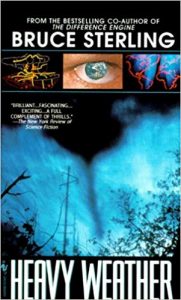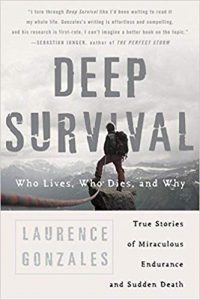Welcome to a stormy world. Canadian climate scientist Paul Beckwith and I cover the breaking science news behind the big storms and strange times. It’s not just you: the record weather on the outside, with a climate shift behind it all. From a hot Arctic to the hurricanes we investigate the big picture, while Billionaires tell us to “get used to it”.
I’ve also added links to with some other headlines, beyond our interview.
Listen to or download this Radio Ecoshock show in CD Quality (57 MB) or Lo-Fi (14 MB)
There is a long shopping list of recent extreme weather and scary new science out there. It is strange times in Portugal, the Florida Panhandle, Wales, and even Paul Beckswith’s home town of Ottawa Canada. Did I mention the IPCC and our record carbon bonfire this year? But there is another huge climate story getting missed, and Paul has it.
Our guest is climate scientist Paul Beckwith. Paul taught at Canadian Universities, and these days he teaches the world through his You tube videos, and appearances on Radio Ecoshock.
Paul has done a lot of videos about the Arctic. I could call it his specialty. Honestly, when I just got notification of two new videos on missing Arctic sea ice, I sighed and wondered “What is Paul on about now?” After 13 years of covering the climate beat, I’m pretty jaded about the possibilities. But watching his new stuff, I was shocked again.
You can watch Paul Beckwith’s two new videos on You tube. Look for “Profound Climate Mayhem With NO Arctic Sea-Ice” and “Part 2: Profound Climate Mayhem With NO Arctic Sea-Ice”. You can find those with a Google search, on Paul Beckwith’s Youtube channel, or at his web site paulbeckwith.net.
In this radio interview we build methodically toward understanding this new climate force – which will shift life in the Northern Hemisphere and beyond. We start with the situation with Arctic sea ice in 2018. This year is not a record low, but is among the group of lowest sea ice in September (the peak generally measured).
Previously, Paul predicted a year for the “Blue Ocean Event” where sea ice is gone, at least for the summer. He got the time wrong. Personally, I don’t think the year matters. Scientists agree that sooner of later we will see an open Arctic Ocean, likely with a couple of small patches of ice in channels around the Canadian Archipelago.
AFTER THE SEA ICE IS GONE: A NEW SOURCE OF HEAT IN THE ARCTIC
Let’s say the sea ice does disappear for the summer, and the Arctic becomes a wide-open sea for months. The crux of Paul’s two new videos is: what happens when winds blow over the newly open Arctic Sea, unobstructed over long distances? There will be larger waves, due to the longer “reach” (length for waves to develop). Those waves will stir up a vast pod of warmer water hidden below the Western Arctic ocean. The warmer water has more salt concentration, allowing a cooler layer to stay above it. But stronger polar winds could churn it up, releasing more heat into the atmosphere – another feedback loop.
The stronger, longer winds can develop a kind of pumping effect that can draw the warmer water up. This becomes a brand new source of heat in the Arctic, another unexpected force in climate change.
To understand how wind can churn water well below the surface, we need to grasp the basic concept of the “Coriolis Effect”. You can find an explanation of that basic term here in Wikipedia.
But Paul has better diagrams of how this all works in his two You tube videos.
TORNADOES AND MORE VIOLENT WEATHER
We cycle back to more Arctic news later in this interview. But let’s get closer to home, much closer to Paul’s home, in Canada’s capital – Ottawa Ontario. Paul survived a blitz of tornadoes there. He describes the strange event for us.
There isn’t a big history of tornadoes in Ontario Canada. I grew up in Southern Ontario. We feared the atomic bomb but never a tornado. On May 21st, 1953 an amazing tornado hit the oil and chemical town of Sarnia. There was another horror in Barrie Ontario in 1985. But it’s hardly “tornado alley”, so we have to wonder if changes to the Jet Stream and other climate shifts are already occurring.
TORNADO ALLEY IS MOVING EAST!
Here is proof of one of those changes. We have breaking science just published October 17th in the Nature’s npj Climate and Atmospheric Science journal. Scientists Vittorio A. Gensini & Harold E. Brooks show that America’s terrifying “Tornado Alley” appears to be shifting to the East. They find, quote: “Negative tendencies of tornado occurrence have been noted in portions of the central and southern Great Plains, while robust positive trends have been documented in portions of the Midwest and Southeast United States.” That’s going to come as a shock to millions of people who thought tornadoes were for other people…
The other “odd” factor: a swarm of tornadoes hit Pennsylvania on Tuesday October 2nd. It was a record, being the most tornadoes to hit the state in a single day, AND because this all happened so late in the fall. Again, the team of Gensini and Brooks say they don’t know if that shift in tornado timing is caused by global warming. Something is happening.
HURRICANE MICHAEL – POWERED BY OCEAN HEAT
Let’s talk about the wildly destructive Hurricane Michael hitting the Florida panhandle on October 10, 2018. Only a few days before, Michael was just a tropical disturbance. It pretty unnerving for one of the strongest hurricanes in U.S. history to wind up in just a few days. How could that happen so fast?
hIn addition to a deadly storm surge, there was a surge of major television networks openly talking about the contribution of climate change to Michael’s strength. I wonder what caused the mainstream media to move from climate silence to authority figures talking about climate and storms?
(All this storm reporting reminds me of the 1990’s novel “Heavy Weather” by Bruce Sterling. Should our listeners in the Southeast United States, and the Eastern Seaboard prepare for more flooding and more violent storms?)

Speaking of strange storms, Spain and Portugal hardly ever see an actual hurricane. I think one struck in the 1800’s. But on Saturday October 14th Hurricane Leslie struck Portugal with winds of 109 miles per hour, which is 175 kilometers per hour. Things are getting unpredictable.
Here is another headline from Europe: “12 dead after worst flash floods in 100 years in France” That was published October 16. It goes on “Up to seven months’ rain fell in just a few hours overnight, local officials said, catching sleeping residents by surprise and isolating villages.” There we go, another extreme rainfall event. They are popping up all over the world.
On October 16th, a storm called Callum flooded hundreds of homes across Wales. It was billed as the “worst flooding in 30 years”. Added to terrible storms this year in the Pacific, especially in Japan, all this makes me wonder: is 2018 a freak year, or maybe the “new normal” in a broken climate system?
Not to long ago, Dr. James Hansen, former Chief Scientist at NASA, warned that storms stronger than any seen in our past records could blow up out of the Atlantic. What was he talking about, and does it relate to what we are seeing already?
PAUL’S TAKE ON THE LATEST IPCC REPORT RE: 1.5 DEGREES
Moving on to the latest report by the Intergovernmental Panel on Climate Change. The final report on 1.5 degrees of warming found another magical ten or fifteen years of fine fossil fuel living before we really have to change. Paul, found a few problems with this report from the IPCC. Here are some summary points from his video on this:
“My take on @IPCC_CH Report:
-abrupt climate change will soon blow away 1.5C and 2C
-baseline shifted from 1750 to 1850-1900 average (up to 0.3 C difference)
-downplays methane
-downplays cascading climate feedbacks, like total loss of Arctic sea-ice”
BILL GATES
Here is a headline in the New Scientist from October 16: “Bill Gates leads global call to accept realities of a warming planet“. This article just made me angry. It includes plenty of quotes from an official at the World Bank, saying we need to prepare for the coming climate mess. This is from the same World Bank that until just a couple of years ago funded coal plants all over the world.
This is from the same Bill Gates who kept quiet about global warming when he was in a position to call for big changes and pay for some of them. Now they admit the climate game is lost, and we should all dig in to adapt to the coming drought, failing agriculture, and millions of heat deaths. Even though they are right, the timing turns my stomach. We knew this would happen Paul: first they make it happen, then they deny it’s happening, then they tell us to adapt. You saw that coming, right?
For more on Gates and climate, check this article sent to me by ClimateHome News. And the European Commission issued this press release: “Climate change: European Commission and Bill Gates-led Breakthrough Energy launch €100 million clean energy investment fund” – released
October 17, 2018.
Here is another pithy question asked in recent science: Does climate vary more from century to century when it is warmer? A Press Release from University College London says, quote: “The Last Interglacial period contained an interval of intense Arctic warming, with surface air temperatures estimated at 3-11°C above pre-industrial, comparable to high-latitude warming scenarios for the end of this century.” The paper asks about whether climate can change more quickly, in time scales as short as a century, during warming phases.
BACK TO THE ARCTIC
It seems everything gets sucked back into the Arctic, so let’s go there again. Here is a new headline from ScienceDaily: Polar Jet Circulation Changes Bring Sahara Dust To Arctic, Increasing Temperatures, Melting Ice. Their story begins:
“Abu Dhabi, October 10, 2018: Research scientists at NYU Abu Dhabi, along with other global researchers, have identified a new mechanism by which warm dust travels from the Sahara Desert to the Arctic Circle, which has been proven to affect rising temperatures and ice melt in Greenland.”
There’s another whole story in dust getting to the Arctic. Danish ice expert Jason Box has already published photos of parts of Greenland turned grey instead of the expected pristine white. Naturally this dust surface absorbs heat from the sun, and speeds up ice melt, which speeds up sea level rise.
MORE RAPID ICE MELT ON THE VAVILOV ICE CAP

Graphic courtesy of CIRES
Back in the Russian High Arctic, something called the Vavilov Ice Cap was sliding along at about 2 inches a day. But now it’s going much faster: 82 feet a day according to CIRES scientist Mike Willis. It’s much faster than expected they say, but that is what we are hearing from scientists all over. Anyway, glaciers and ice caps cover 300,000 square miles of Earth’s surface and they are disappearing. Robert Hunziker covers this well in Counterpunch on October 10, 2018.
Also reported October 11, 2018, there has been an “Unprecedented Lack of Refreeze Across Arctic as Ice Continues to Melt“. What is holding back the refreeze this winter?
Ice extent across the Arctic Ocean reached its annual minimum about two weeks ago. At this point ice would normally be forming rapidly, especially in the center of the Arctic Ocean. However, ice coverage in the Central Arctic Basin, the largest part of the Arctic Ocean comprising around 4.5 million square kilometers, continues to decline puzzling climate scientists.
This region has never before experienced continued melting this late into fall. Even during the record-low years of 2007 and 2012 the center of the Arctic Ocean was freezing over rapidly by mid-October. Robert Hunziker writes:
“In fact now ice extent in the Central Arctic Basin is second lowest for the day. Its slightly below the overall record year 2012. Only in the year 2007 there was less ice in the Central Arctic on this day of the year,” says Lars Kaleschke from the Center of Marine and Atmospheric Research (ZMAW) at the University of Hamburg. About 500,000 square kilometers of ice coverage are missing – about the size of Sweden – compared to the previous five years.”
We know Russia is all in favor of a new open ocean along their vast northern coastline. That means more access to still more fossil fuels, plus mines, commercial ship traffic, and maybe growth in their north. Where is Canada in the research, and in planning for impacts of the new Blue Ocean?
THE CARBON BONFIRE: WORLD HITS THE 100 MILLION BARRELS RECORD

While we desperately reach for stories of new solar and wind farms opening, and cities finally cutting food waste, let’s not forget we have our foot still firmly pressed on the accelerator of doom. Here is a story from the business paper Bloomberg news, published October 12th.
“The world is pumping out more oil and other petroleum liquids than ever before. Global supply rose to 100.3 million barrels a day in the third quarter, the International Energy Agency said Friday in its monthly oil market report. Output, which includes crude oil, natural gas liquids, biofuels and refinery processing gains, was 2.3 million barrels above the same period last year and 1.3 million barrels a day higher than the second quarter.”
– Bloomberg news
We are burning more than ever!
I’ve got an interview coming up with Jean-Paul Jancovici. He’s sort of the Richard Heinberg of France, with a history of talking about both climate and peak oil. Although Jancovici will be careful to say “conventional oil” production peaked around 2005, the awful fact just revealed by Bloomberg is it doesn’t really matter where the fossil fuels come from, it’s hard to talk about “Peak Oil” when we just hit a new record for production. Of course the IEA total includes fracked oil and gas, as well as biofuels. Keep an ear out for my discussion with Jean-Paul Jancovici.
OUR RECORD CARBON DIOXIDE INTO THE ATMOSPHERE!
Of course, since we are burning more and more fossil fuels, guess what: shocker! Carbon dioxide in the atmosphere broke another record in 2018. We went over 411 parts per million in May of this year, the highest monthly average ever recorded at the Mauna Loa Observatory in Hawaii. The article at YaleEnvironment360 adds this hair-raising statement:
“In addition, scientists found that the rate of CO2 increase is accelerating, from an average 1.6 ppm per year in the 1980s and 1.5 ppm per year in the 1990s to 2.2 ppm per year during the last decade.”
THE MEDIAN IS NOT THE MESSAGE
Kurt Kobb has a terrific blog post about the misleading assumption (by the IPCC and everybody else) that our common future will follow the most likely path. If a carbon future has a 60 percent change of happening, that means it has a huge chance of crashing completely! It’s called “the fat tail problem”. That’s all in the blog published October 14, 2018 “Climate catastrophe: The median is NOT the message”.
“As famed student of risk Nassim Nicholas Taleb wrote in his book Fooled by Randomness, “It does not matter how frequently something succeeds if failure is too costly to bear.” Industrial civilization continues to mount new records of production and wealth. And yet, if its current path results in societal collapse, that path can hardly be counted as a benefit.”
– Kurt Kobb from his Resource Insights blog.
You can download my two part interview with Kurt Kobb in March, 2010 here: Part 1 (21 minutes) and Part 2 (25 minutes)
Kurt appeared on Radio Ecoshock 2010 03 26 “Peak Oil” Dark Optimism”,
DEEP SURVIVAL: RECOMMENDED BY PAUL
Paul has been reading two books he recommends. They are “Deep Survival who lives who dies and why” by Lawrence Gonzales; “Surviving Survival” the emotional impacts of surviving. Find them both here at Lawrence’s web site. There is a new edition of Deep Survival just out.

If you made it all the way to the end of this blog, you get another Radio Ecoshock gold star! Please pass on any info and links you found helpful. I also count on my listeners to post about this program throughout social media. We are slowly building an audience all over the world. People get to hear about science and action from the scientists and activists. Only you can make this happen.
I also depend on listener donations to help me make the program. Without your support, I suppose I’d have to get a job doing something else. There is no where else to find such a large and continuing stream of information about the coming climate shift. Maybe eventually I’ll find a team of volunteer guest hosts to cover this beat. As long as I can, I will keep going, keep digging, keep asking. Please keep giving your financial support, large or small, if you can.
Thank you so much for listening and reading!
Alex
Pingback: Climate and Nuclear News to 31 October – Australia and International | Nuclear Australia